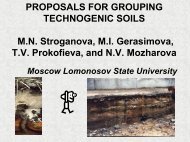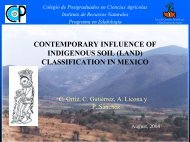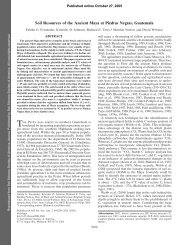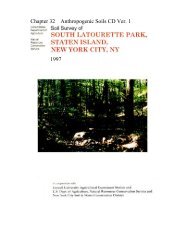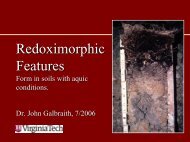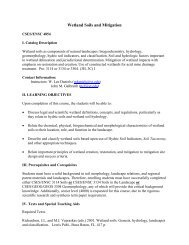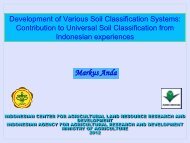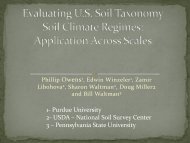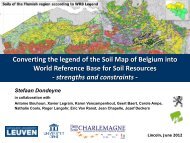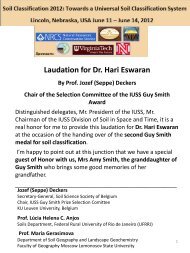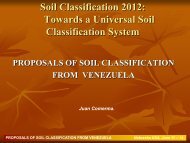Nebraska Soils Field Trip - Virginia Tech
Nebraska Soils Field Trip - Virginia Tech
Nebraska Soils Field Trip - Virginia Tech
Create successful ePaper yourself
Turn your PDF publications into a flip-book with our unique Google optimized e-Paper software.
4th IUSS Soil Classification Conference <strong>Field</strong> Tour Guidebook<br />
Bt4--86 to 107 centimeters; brown (10YR 5/3) silty clay loam, pale brown (10YR 6/3) dry;<br />
prominent strong brown (7.5YR 5/6) iron masses in the soil matrix; the iron accumulations are<br />
relict redox features; strong coarse prismatic structure parting to moderate medium subangular<br />
blocky; hard, firm; few very fine roots throughout; common very fine tubular pores; common<br />
distinct brown (10YR 4/3) discontinuous clay films (cutans) on vertical and horizontal faces of<br />
peds; common fine irregular soft masses of iron-manganese; slightly acid; gradual smooth<br />
boundary. (combined thickness of the Bt horizons is 46 to 122 centimeters)<br />
BC--107 to 152 centimeters; brown (10YR 5/3) silty clay loam, very pale brown (10YR 7/3) dry;<br />
many coarse distinct yellowish brown (10YR 5/6) iron masses in the soil matrix; the iron<br />
accumulations are relict redox features; weak coarse prismatic structure parting to moderate<br />
medium subangular blocky; hard, friable; few very fine roots throughout; common fine tubular<br />
pores; common discontinuous pressure faces on vertical faces of peds; many fine and medium<br />
irregular soft masses of iron-manganese; slightly acid; gradual smooth boundary. (15 to 51<br />
centimeters thick)<br />
C--152 to 203 centimeters; grayish brown (2.5Y 5/2) silt loam, light gray (2.5Y 7/2) dry; many<br />
fine prominent strong brown (7.5YR 5/8) and common medium strong brown (7.5YR 5/6) iron<br />
masses in the soil matrix; the iron accumulations are relict redox features; massive; hard, friable;<br />
common fine tubular pores; discontinuous pressure faces on vertical faces of peds; many fine and<br />
medium irregular soft masses of iron-manganese; neutral.<br />
TYPE LOCATION: Saunders County, <strong>Nebraska</strong>; about 9.7 kilometers south and 6.4 kilometers<br />
east of Wahoo; 247 meters north and 571 meters west of the southeast corner, Sec. 4, T. 13 N.,<br />
R. 8 E. USGS Wahoo Southeast topographic quadrangle; lat. 41 degrees, 7 minutes, 12 seconds<br />
N. and long. 96 degrees, 31 minutes, 39 seconds W.,NAD 83.<br />
RANGE IN CHARACTERISTICS:<br />
Depth to argillic horizon: 15 to 51 centimeters<br />
Depth to redox concentrations: 30 to 91 centimeters. The redox pattern is a relict feature and not<br />
considered indicative of present drainage conditions.<br />
Thickness of the mollic epipedon: 25 to 61 centimeters (extends into the upper part of the Bt<br />
horizon) (>50 cm is Pachic would change classification)<br />
Particle-size control section (weighted average):<br />
Clay content: 35 to 42 percent<br />
A horizon:<br />
Hue: 10YR<br />
Value: 2 or 3 (3 or 4 dry)<br />
Chroma: 1 or 2 (moist and dry)<br />
Texture: silty clay loam<br />
Clay content: 27 to 35 percent<br />
Reaction: slightly acid to strongly acid<br />
52



